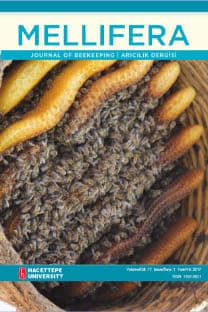Eupatorium cannabinum L. Poleninin Morfolojisi
Bu araştırmada, geniş medikal kullanımı olan aromatik Eupatorium L. (Asteraceae) cinsine ait Eupatorium cannabinum L. polen morfolojisi ışık mikroskobu (LM) ile incelenmiştir. Yapılan incelemelere göre, bu taksona ait polenler radyal simetrik, izopolar, oblat-siferoid, trikolporat, ekinat özellik göstermektedir. Bu taksonlara ait palinolojik özelliklerin çeşitli palinolojik, taksonomik ve farmasötik botanik çalışmalarında taksonların daha doğru teşhis edilmesine yardımcı olacağını düşünmekteyiz.
Anahtar Kelimeler:
Asteraceae, Eupatorium cannabinum, ışık mikroskobu, palinolojik, taksonomik araştırmalar.
Pollen Morphology of Eupatorium cannabinum L.
In this paper, pollen morphology of Eupatorium cannabinum L., belonging to the aromatic genus Eupatorium L. (Asteraceae), which has widely medicinal use, were examined with light microscope (LM). According to the investigation, pollen grains of the species is radially symmetrical, isopolar, oblate-spheroidal, tricolporate and echinate. In our opinion, the palynological features of the taxon might be helpful to investigate the taxon in various palynological, taxonomical and pharmaceutical researches.
Keywords:
Asteraceae, Eupatorium cannabinum, light microscope, palynological, taxonomical researches.,
___
- ZHANG, M L; WU, M; ZHANG, J J; IRWIN, D; GU, Y C; SHI, Q W (2008) Chemical Constituents of Plants from the Genus Eupatorium. Chemistry & Biodiversity, 5: 40-55.
- ISTUDOR, V (2001) Farmacognozie Fitochimie Fitoterapie, Ed. Medicala, Bucuresti, p. 178-1799
- PELLETT, F C (1930) America Honey Plants, Together with Those which are of Special Value to the Beekeeper as Sources of Pollen. 3rd ed. Hamilton, Illinois: American Bee Journal.
- PELLETT F C. 1976. American Honey Plants. 4th ed. Carthage, Illinois: Orange Judd Publishing Co., Inc
- BASTOS, D H M; BARTH, O M; ROCHA, C I; CUNHA I B S; CARVALHO, P O; TORRES, E A S; MİCHELAN, M (2004) Fatty Acid Composition and Palynological Analysis of Bee (Apis) Pollen Loads in the States of Sao Paulo and Minas Gerais, Brazil. Journal of Apicultural Research, 43 (2): 35–39.
- TIWARI P; TIWARI J K; BALLABHA R (2010) Studies on Source Bees Forage for Rock bee (Apis dorsata F.) from Garhwal Himalaya, India. A mellisopalynological approach. Nat. Sci. 8(6): 5-15.
- LEXA A; FLEURENTİN J; YOUNOS C; MORTİER F (1990) Study of Antihepatotoxicity of Eupatorium cannabinum L. in Mice. An Adequate Method of Screening in Vivo Antihepatotoxic Natural Principles. Phytother. Res., 4: 148-151.
- FLAMINI G; CIONI P L; MORELLI L (2003) Analysis of the Essential oil of The Leaves and Flowers/Fruits of Eupatorium cannabinum L. from south Tuscany (Central Italy). J. Essent. Oil Res., 15: 127-129.
- IQBAL DAR A; SAXENA R C; MATADEEN B; BARELA B; JADHAW V (2013) Toxicity of Eupatorium cannabinum L. Against Second and Fourth İnstar Larvae of Culex Quinquefasciatus and Aedes Aegypti. International Journal Of Research In Ayurveda and Pharmacy, 4(1): 63-66.
- RIBEIRO VARANDAS E; RESSURREIÇÃO F; VIEGAS W; DELGADO M (2014) Cytotoxicity of Eupatorium cannabinum L. Ethanolic Extract Against Colon Cancer Cells And Interactions With Bisphenol A And Doxorubicin. BMC Complementary and Alternative Medicine, 14: 264.
- DAVIS PH (1965-1985). Flora of Turkey and the East Aegean Islands. Vol. 1-9. Edinburgh: Edinburgh University Press.
- WODEHOUSE RP. 1930. Pollen grains in identification and classification of plant V. haplopappus and other Asteraceae: the origin of their furrow configuration. Bull Torrey Botan Club 57: 21–46.
- ERDTMAN G. 1969. Handbook of Palynology: Morphology, taxonomy, ecology. Copenhagen, Munksgaard.
- PUNT W; HOEN P P; BLACKMORE S; NILSSON S; LE THOMAS A (2007) Glossary of Pollen and Spore Terminology. Rev Palaeobot Palynol 143: 1-81.
- JEROLD L; GRASHOFF J H (1970) Beaman Studies in Eupatorium (Compositae), III. Apparent Wind Pollination. Brittonia, 22 (1): 77-84
- ISSN: 1302-5821
- Başlangıç: 2001
- Yayıncı: Hacettepe Üniversitesi
Sayıdaki Diğer Makaleler
TÜRKİYE’DE ORDU İLİNDEN ELDE EDİLEN PROPOLİSİN ANTİMİKROBİYAL AKTİVİTESİ
Ömer Ertürk, Ceren Yavuz, Recep Sıralı
Eupatorium cannabinum L. Poleninin Morfolojisi
İlginç KIZILPINAR TEMİZER, Zafer TÜRKMEN
Nesrin Ecem BAYRAM, Mehmet KARADAYI, Medine GÜLLÜCE, Sinan BAYRAM, Kadriye SORKUN, Gül Cevahir ÖZ, Mehmet Nuri AYDOĞAN, Taha Yasin KOÇ, Burak ALAYLAR, Bekir SALİH
Azerbaycan Propolislerinin Antioksidan Potansiyeli ve Fenolik Profili
Zehra CAN, Oktay YILDIZ, Hüseyin ŞAHİN, Alsever ASADOV, Sevgi KOLAYLI
Sinop İlinin Farklı İlçelerine Ait Bal Örneklerinin Palinolojik Analizi
